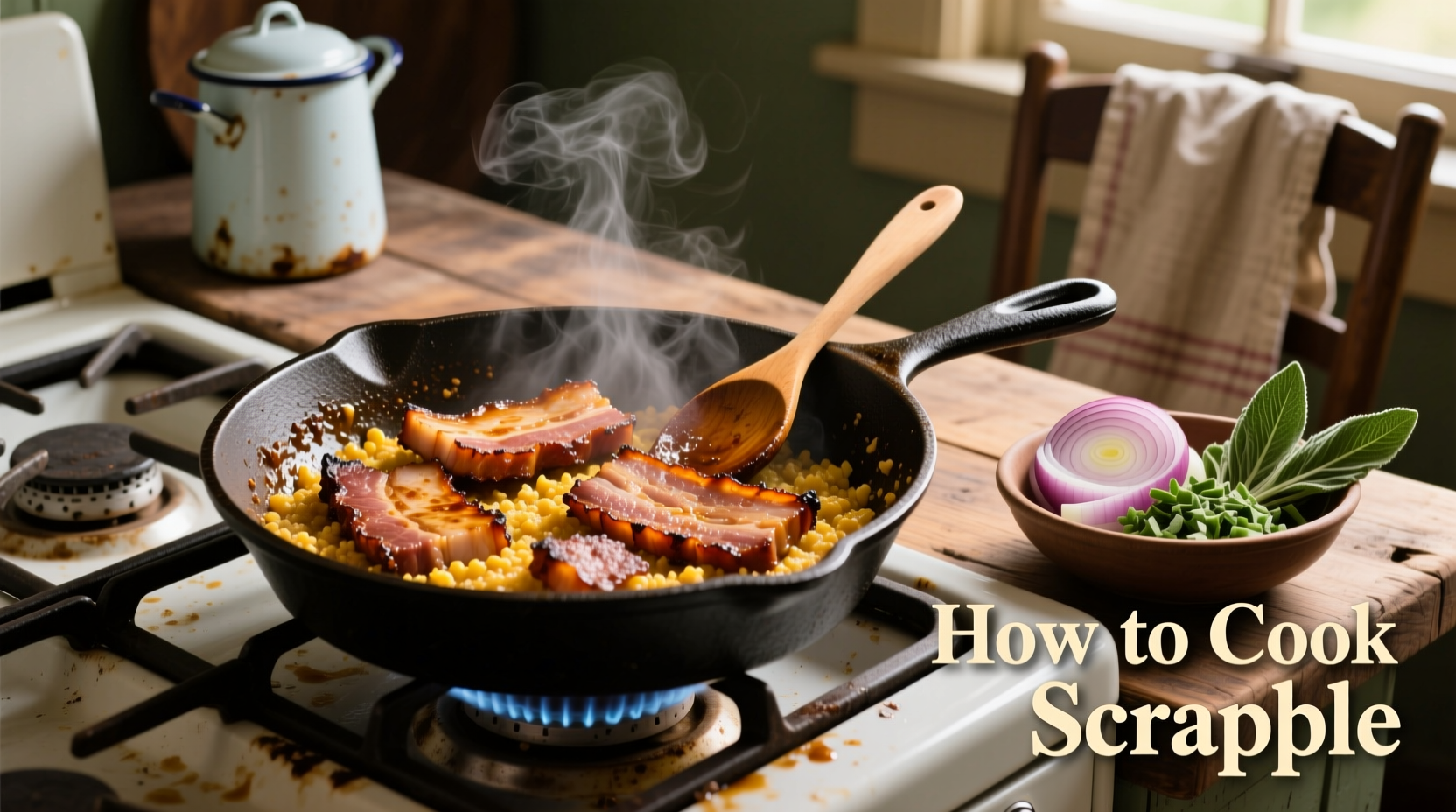Scrapple might look intimidating with its loaf-like appearance, but cooking it properly unlocks a delicious breakfast tradition that's been satisfying Pennsylvania Dutch communities for centuries. This humble pork-based dish transforms into something extraordinary with the right technique - crispy edges giving way to a savory, tender center that pairs perfectly with eggs and maple syrup.
Understanding Scrapple Before You Cook
Before you heat your skillet, understanding what scrapple is helps you cook it better. Scrapple originated as a "nose-to-tail" cooking solution where early American settlers used pork scraps, broth, and cornmeal to create a shelf-stable food. Modern scrapple contains ground pork, spices (typically sage, thyme, and black pepper), and cornmeal or buckwheat.
Unlike sausage or bacon, scrapple has a unique texture that requires specific cooking methods. The cornmeal binder means it can become gummy if not cooked properly, while the pork content needs thorough heating for food safety. According to USDA food safety guidelines, pork products should reach an internal temperature of 165°F to eliminate potential pathogens (USDA Food Safety).
Selecting Quality Scrapple
Your cooking success starts at the store. Look for scrapple with:
- Clear ingredient listing with recognizable components
- Firm texture without excessive moisture
- Recent production date (scrapple is best used within 5-7 days of purchase)
- Visible meat particles rather than homogenous texture
Local Pennsylvania Dutch markets often carry superior scrapple compared to mass-produced varieties. If possible, seek out brands that use traditional recipes with minimal preservatives for the most authentic flavor profile.

Essential Preparation Steps
Proper preparation prevents common cooking failures:
- Slice correctly: Cut 1/2-inch thick slices using a sharp knife. Thinner slices become too crispy, while thicker ones won't heat through properly.
- Dry the surface: Pat slices thoroughly with paper towels to remove excess moisture that causes steaming instead of browning.
- Rest at room temperature: Let slices sit for 10-15 minutes before cooking to reduce thermal shock that can cause crumbling.
- Preheat your pan: Use medium heat (around 325°F) - too hot causes burning, too low creates greasy results.
The Perfect Pan-Frying Technique
Follow these steps for consistently excellent results:
- Heat 1-2 tablespoons of oil (vegetable, canola, or bacon grease) in a cast-iron skillet over medium heat.
- Arrange scrapple slices in a single layer without crowding the pan.
- Cook undisturbed for 4-5 minutes until golden brown and releases easily from the pan.
- Flip carefully using a thin spatula and cook another 4-5 minutes until second side is crispy.
- Check internal temperature reaches 165°F using an instant-read thermometer.
- Transfer to a wire rack (not paper towels) to maintain crispness while draining excess oil.
Resist the urge to press down on the scrapple while cooking - this squeezes out flavorful juices and creates uneven browning. The ideal finished product should have a deep golden crust with a tender but firm interior that holds together when sliced.
| Cooking Method | Temperature | Cooking Time | Best Result |
|---|---|---|---|
| Pan-Frying (recommended) | Medium (325°F) | 4-5 min per side | Crispy exterior, tender interior |
| Baking | 375°F | 15-20 min | Evenly cooked but less crispy |
| Air Frying | 360°F | 8-10 min | Crispiest exterior, watch carefully |
Context Boundaries: When to Adjust Your Technique
Not all scrapple is created equal, and your cooking method should adapt to these variables:
- High-moisture scrapple: If your scrapple seems wetter than usual, increase drying time and use slightly higher heat to evaporate moisture quickly.
- Cornmeal-heavy varieties: These benefit from slightly lower temperatures to prevent the exterior from burning before the interior heats through.
- Cold kitchen environments: Allow extra resting time at room temperature (up to 20 minutes) to prevent thermal shock when placing cold scrapple in a hot pan.
- Cast iron vs. non-stick: Non-stick pans require slightly lower heat settings as they heat more quickly and evenly than cast iron.
Serving Suggestions That Elevate Your Meal
While scrapple stands well on its own, these pairings create a complete breakfast experience:
- Traditional: Fried eggs, apple butter, and strong coffee
- Modern twist: Poached eggs with hollandaise sauce and roasted potatoes
- Sweet contrast: Maple syrup drizzle with fresh apple slices
- Spicy option: Hot sauce or jalapeño slices for heat lovers
For the best texture experience, serve immediately after cooking. Scrapple loses its ideal crisp-tender balance if held too long before serving. If cooking for a crowd, keep finished batches warm in a 200°F oven on a wire rack - never stack slices as this creates steam that softens the crust.
Common Mistakes and How to Avoid Them
Even experienced cooks make these scrapple errors:
- Overcrowding the pan: Causes steaming instead of frying. Cook in batches if necessary.
- Flipping too early: Wait until scrapple releases naturally from the pan surface.
- Using insufficient oil: Scrapple needs adequate fat for proper browning and to prevent sticking.
- Skipping the resting step: Cold scrapple placed directly in hot oil will splatter excessively and cook unevenly.
- Pressing while cooking: Squeezes out flavorful juices and creates uneven texture.
If your scrapple crumbles during cooking, the loaf was likely too cold or the pan wasn't properly preheated. Next time, allow more resting time and ensure your oil is shimmering but not smoking before adding slices.
Storage and Reheating Tips
While scrapple is best enjoyed fresh, leftovers can be stored properly:
- Refrigerate cooked scrapple in an airtight container for up to 3 days
- Reheat in a skillet over medium heat (not microwave) to restore crispness
- Uncooked scrapple maintains quality for 5-7 days refrigerated or 2-3 months frozen
- Thaw frozen scrapple in the refrigerator before cooking for best results
Properly reheated scrapple won't match the texture of freshly cooked, but the skillet method comes closest to restoring that desirable crispy exterior.











 浙公网安备
33010002000092号
浙公网安备
33010002000092号 浙B2-20120091-4
浙B2-20120091-4